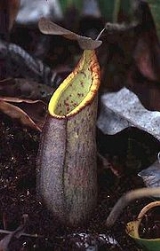
Nepenthes lavicola
Encyclopedia
Nepenthes lavicola is a tropical pitcher plant
species endemic to northern Sumatra
. It is thought to be most closely related to N. singalana
and N. spectabilis
.
Nepenthes lavicola is notable for its very prominent bract
s, which often overarch the flowers and may be up to 7 cm long at the base of female inflorescence
s. This species is also unusual in that it bears up to two bracts per pedicel or partial peduncle.
Swiss
botanist Albert Friedrich Frey-Wyssling mentioned N. lavicola in a 1931 article as an unidentified Nepenthes species.
Nepenthes lavicola has no known natural hybrids. No forms or varieties have been described.
Pitcher plant
Pitcher plants are carnivorous plants whose prey-trapping mechanism features a deep cavity filled with liquid known as a pitfall trap. It has been widely assumed that the various sorts of pitfall trap evolved from rolled leaves, with selection pressure favouring more deeply cupped leaves over...
species endemic to northern Sumatra
Sumatra
Sumatra is an island in western Indonesia, westernmost of the Sunda Islands. It is the largest island entirely in Indonesia , and the sixth largest island in the world at 473,481 km2 with a population of 50,365,538...
. It is thought to be most closely related to N. singalana
Nepenthes singalana
Nepenthes singalana is a highland Nepenthes pitcher plant species native to the island of Sumatra. It is most closely related to N. diatas and N. spathulata.-Taxonomy:...
and N. spectabilis
Nepenthes spectabilis
Nepenthes spectabilis is a tropical pitcher plant endemic to Sumatra, where it grows at elevations of between 1400 and 2200 m above sea level. The specific epithet spectabilis is Latin for "visible" or "notable".-Botanical history:...
.
Nepenthes lavicola is notable for its very prominent bract
Bract
In botany, a bract is a modified or specialized leaf, especially one associated with a reproductive structure such as a flower, inflorescence axis, or cone scale. Bracts are often different from foliage leaves. They may be smaller, larger, or of a different color, shape, or texture...
s, which often overarch the flowers and may be up to 7 cm long at the base of female inflorescence
Inflorescence
An inflorescence is a group or cluster of flowers arranged on a stem that is composed of a main branch or a complicated arrangement of branches. Strictly, it is the part of the shoot of seed plants where flowers are formed and which is accordingly modified...
s. This species is also unusual in that it bears up to two bracts per pedicel or partial peduncle.
Swiss
Switzerland
Switzerland name of one of the Swiss cantons. ; ; ; or ), in its full name the Swiss Confederation , is a federal republic consisting of 26 cantons, with Bern as the seat of the federal authorities. The country is situated in Western Europe,Or Central Europe depending on the definition....
botanist Albert Friedrich Frey-Wyssling mentioned N. lavicola in a 1931 article as an unidentified Nepenthes species.
Differences between N. lavicola, N. singalana and N. spectabilis (Wistuba & Rischer, 1996) Character N. lavicola N. singalana N. spectabilis Shape of lower pitchers urceolate to globose basal part infundibuliform, cylindrical in the upper part ovate in the lower part, cylindrical in the upper part Shape of upper pitchers slender, lower part infundibuliform to ovate then ventricose, slightly hipped in the middle narrowing to the somewhat waisted cylindrical upper part lower half infundibuliform, mostly ventricose in the middle, cylindrical or slightly narrowed towards the mouth infundibuliform in the lower half, tubulose in the upper half Colour of pitchers usually dark brownish purple to almost black, peristome yellowish green, sometimes with red stripes, occasionally colour of pitchers yellowish green with blackish spots, innerside of the pitchers pale green, in the lower pitchers red spotted light green to dark red, violett spotted or not light green, with numerous longitudinal dark violett - brown stripes and spots Lid ovate-cordate suborbicular, cordate at the base orbiculate Spur up to 0.5 cm in length, branched in case of lower pitchers 2-3 mm, slightly flattened, not branched 2 cm in length, simple Spur insertion close to the lid base close to the lid 5-10 mm below the lid base Floral bracts bracts very prominent, usually overarching the flowers, some of the lower ones reaching several cm in length male: filiform bract, female: without bract pedicels bearing filiform bracts Fruit 2-3 times as long as broad, up to 1.8 cm long up to 30 mm long very slender, 4-5 cm in length
Nepenthes lavicola has no known natural hybrids. No forms or varieties have been described.

